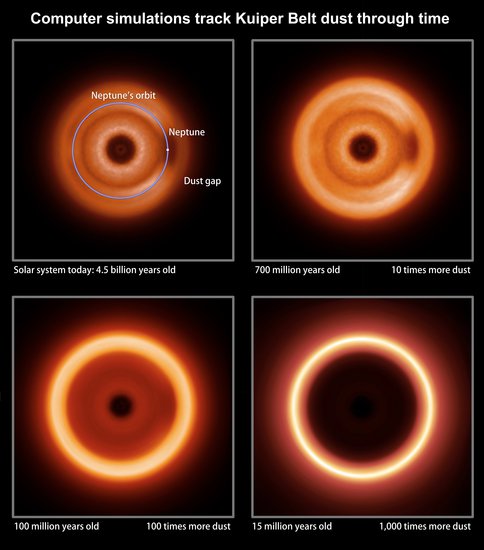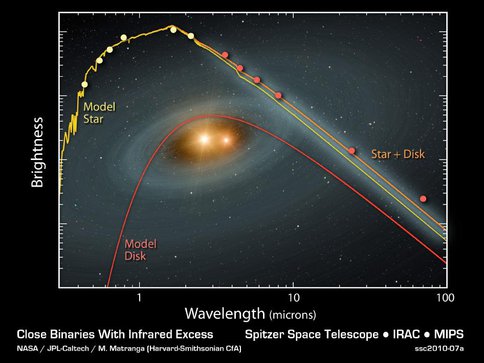2010 Annual Science Report
 NASA Goddard Space Flight Center
Reporting | SEP 2009 – AUG 2010
NASA Goddard Space Flight Center
Reporting | SEP 2009 – AUG 2010
Debris Disk, Exoplanets, and the Kuiper Belt
Project Summary
Kuchner developed new models of the dust in the Kuiper Belt, showing how the solar system would appear to an outside observer, and allowing us to compare the solar system to images of other, more massive debris disks. At optical depths similar to that of today’s zodiacal cloud, the Kuiper belt dust cloud is a ~15 AU wide ring containing an azimuthal gap at the location of Neptune. At high dust production rates, the dust cloud appears to shrink to a narrow ring located outside Neptune’s orbit. This narrow ring resembles images of debris disks like those around Fomalhaut and HR 4796.
Kuchner also studied a relatively new kind of object: a subclass of RS CVn binary stars with infrared excesses. Using dynamical models of dust sculpted by a binary star, Kuchner helped make the case that these new objects may represent dead planetary systems that have been recently stirred by the evolution of the central binary star.
Project Progress
Marc Kuchner worked on interpreting images of planetary systems: modeling images and other data on circumstellar disks to locate hidden exoplanets via their dynamical influence on the shapes of the disks. This technique may be the only way we can find and measure Neptune-like exoplanets: planets that are too faint to image directly, and too slowly orbiting to detect via their effects on their host stars.
Marc Kuchner and his graduate student Christopher Stark have developed a new tool for studying the distribution of dust in planetary systems, called the collisional grooming algorithm. This technique allows them to produce 3-D models of dust interacting with planets by simultaneously solving the dynamical equations and the number flux equation for the system. These models can be used to models images of the solar system and other debris disks, showing for the first time how grain-grain collisions affect the images.
Kuchner and Stark used these new tools to study the distribution of dust originating in the Kuiper Belt, running the model for roughly 6 weeks on NASA’s the Discover cluster. The new model uses 75,000 grains, about 30 times as many grains as previous models. The grains represent three different sub-populations of Kuiper Belt objects (KBOs)—-classical KBOs, scattered/detached KBOs, and putinos—-and span 3 orders of magnitude in grain size.
With these models Kuchner and Stark synthesized images of the Kuiper Belt under different assumptions about the dust production rate. The images show how the solar system would appear to a distant observer, at various wavelengths, at various stages of the solar system’s evolution. As the dust production rate increases, the models show how grain-grain collisions, together with the gravity of Jupiter, Saturn, Uranus and Neptune, change the shape of the dust cloud.
The models show how Neptune clearly reveals its presence to observers of the solar system via its impact on the Kuiper Belt dust. At optical depths of 10-7, similar to that of today’s zodiacal cloud, the Kuiper belt dust cloud is a ~15 AU wide ring containing an azimuthal gap at the location of Neptune. As the dust production rate is increased and the optical depth reaches that similar to debris disks around other stars, the dust cloud appears to shrink to a narrow ring located outside Neptune’s orbit. This narrow ring resembles images of debris disks like those around Fomalhaut and HR 4796. Upcoming measuresments of Kuiper Belt dust with the New Horizons mission can test these models. A video describing his work aired on youtube.com, and received >100,000 views.
Kuchner and Jang-Condell used an analogous model of gas-rich protoplanetary disks to study images of AB Aurigae, a nearby protoplanetary disk. They modeled how a Jovian-mass planet would affect the appearance of the disk in scattered light, but creating a dimple in the surface of the disk. Their models simultaneously solve the hydrostatic equilibrium equation and the radiative transfer equations for the disk structure. Using these models, they placed an upper limit of 1 Jupiter mass on the mass of a planet in the disk.
Kuchner also studied, with a team from the Harvard-Smithsonian Center for Astrophysics, a relatively new kind of object: a subclass of RS CVn binary stars with infrared excesses. Using dynamical models of dust sculpted by a binary star, Kuchner showed that the size of the central clearing inferred from the spectral energy distributions of the dust was consistent with dynamical clearing of dust by resonant interactions with the binary star. These new objects may represent planetary systems that have been recently stirred by the evolution of the central binary star, which can destabilize them, releasing dust through collisions of asteroids and comets.
Kuchner continues to serve as a disk modeler for several observing teams: the Keck Interferometer Nuller key science program, the NICI key science team, and a new coronagraphic survey of disks using the STIS instrument on Hubble Space Telescope.
Figure 1. Models of the Kuiper Belt dust as seen by a distant observer at 60 microns. For the first time, the models include the effects of collisions among grains. By ramping up the collision rate, the simulations allow us to compare the Kuiper belt through out the solar system’s history to images of other debris disks.
Credit: NASA/Goddard/Marc Kuchner and Christopher Stark
Figure 2. Spectral energy distribution of the RS CVn binary II Pegasi, as measured by the Spitzer Space Telescope. The infrared photometry of the star shows flux in excess of the flux from the stellar photospheres (Model Star) indicating the presence of circumstellar dust, possibly from dust in a fossil planetary system, recently destabilized by the binary star’s evolution.
Image credit: NASA/JPL-Caltech/Harvard-Smithsonian CfA
-
PROJECT INVESTIGATORS:
-
RELATED OBJECTIVES:


